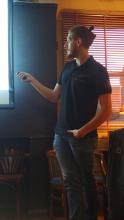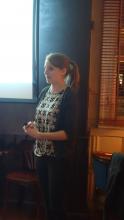Submitted by Jenny Molloy on Wed, 01/11/2017 - 23:42
In October's Cafe Synthetique, Kerstin Göpfrich (Max Planck Institute for Medical Research) introduced her work on DNA 'origami', Alex Ohmann presented on DNA nanopores to rapidly mix lipids between membrane leaflets and Lorenzo di Michele (Department of Physics) discussed amphiphilic DNA complexes
 Lorenzo di Michele discussed the use of amphiphilic DNA ligands/receptors to drive attractive interactions between lipid vesicles, sharing key features with adhering biological cells and displaying an intriguing response to external stimuli.
Lorenzo di Michele discussed the use of amphiphilic DNA ligands/receptors to drive attractive interactions between lipid vesicles, sharing key features with adhering biological cells and displaying an intriguing response to external stimuli.
He introduced a range of amphiphilic DNA nanostructures that reliably self-assemble into 3D macromolecular crystals and therefore how DNA can act as a general purpose material for imposing order in crystalline 3D nanostructures. Lorenzo also introduced his work on binding vesicles together with DNA ligands and the application of structural DNA nanotechnology to produce biosensors.
References:
 Kerstin Göpfrich recently completed her PhD in Prof Ulrich Ketser's lab in the Department of Physics and talked to our enthusiastic audience about use of DNA to build synthetic membrane-inserting channels. These channels have pushed biophysical boundaries from forming the largest man-made pore in a lipid membrane to date, approaching the electrical diameter of the nuclear pore complex, to the construction of the smallest DNA membrane pore made from a single membrane-spanning DNA duplex.
Kerstin Göpfrich recently completed her PhD in Prof Ulrich Ketser's lab in the Department of Physics and talked to our enthusiastic audience about use of DNA to build synthetic membrane-inserting channels. These channels have pushed biophysical boundaries from forming the largest man-made pore in a lipid membrane to date, approaching the electrical diameter of the nuclear pore complex, to the construction of the smallest DNA membrane pore made from a single membrane-spanning DNA duplex.
Kerstin discussed how DNA nanotechnology can enhance synthetic cells, including introducing a new microfluidic method for the sequential bottom-up assembly of synthetic cells. Synthetic DNA nanostructures can also be designed to replicate the structure and function of biological molecules, as well as to create novel synthetic materials. A combination of selective Watson-Crick interactions and robust hydrophobic forces can be realised in amphiphilic nanostructures where nonpolar tags are arranged onto engineered DNA scaffolds.
Alex Ohmann then presented on DNA nanopores to rapidly mix lipids between membrane leaflets - we learnt a lot about flipases and flopases!
References:
- Bottom-up assembly of synthetic cells: Putting the puzzle pieces back together
- Software to build DNA origami: cadnano.org

